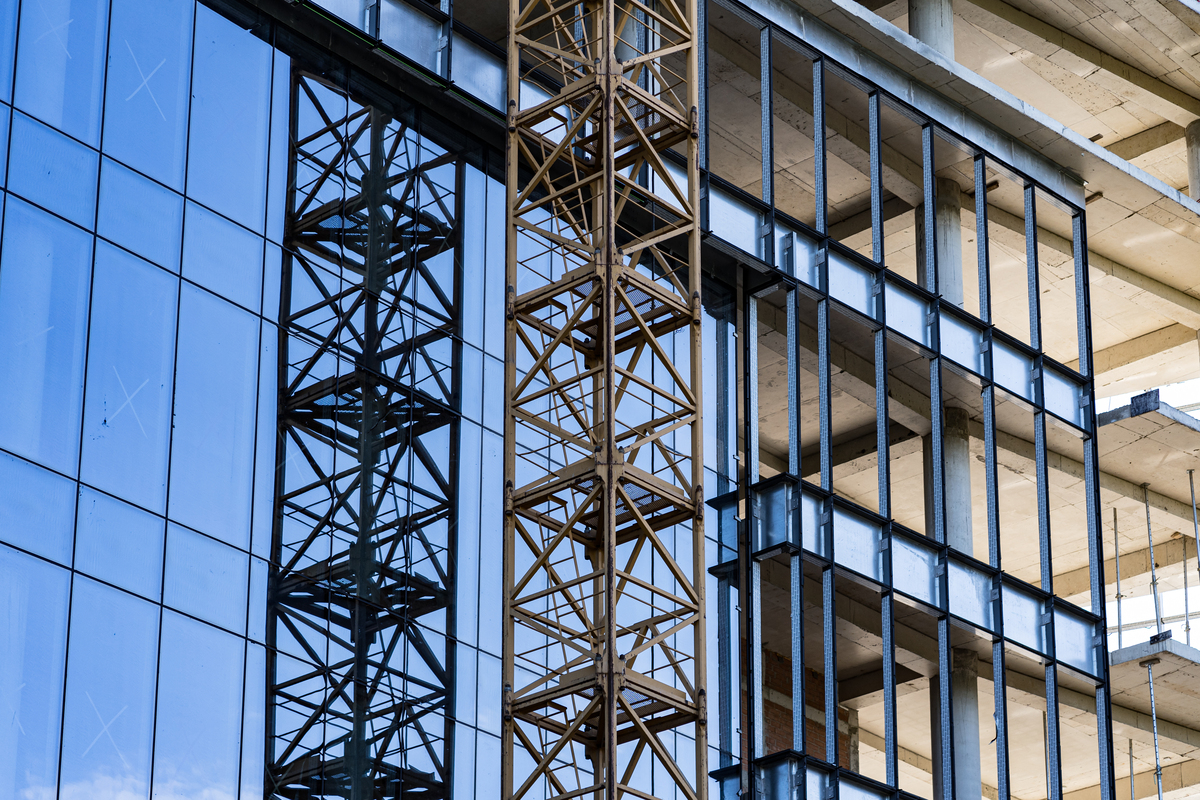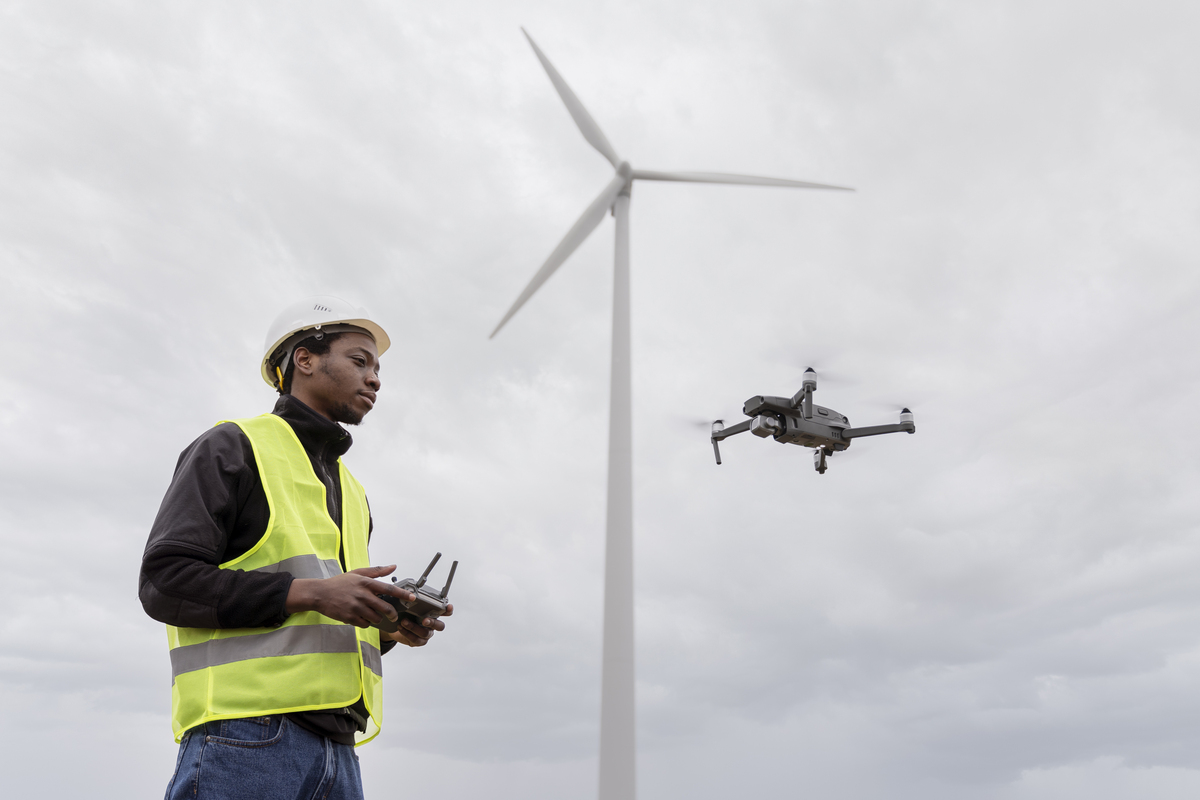Updated by Nazanin Ghodsian, 11/12/2024
With the “Future of Construction” becoming increasingly influenced by contemporary technologies, the construction sector is expanding quickly. The days of managing building projects exclusively by hand are long gone. The industry is currently undergoing a change thanks to digital transformation, which increases project sustainability and efficiency. A survey projects that over the next ten years, construction technology will expand at a compound annual growth rate (CAGR) of 10%, propelled by advancements in BIM, AI, 3D printing, and drone technology.
The future of building will see significant technology changes that prioritize increased efficiency and safety. For example, one of the most popular tools on the internet, sophisticated construction scheduling software, is assisting project managers in improving timetable efficiency, cutting down on delays, and more accurately allocating resources. While BIM and virtual reality enable teams to envision projects before construction begins, drones are being used to check sites and track progress, improving planning accuracy and teamwork.
The use of these technologies is one of the main issues facing construction organizations. Employees frequently experience a learning curve when they use new tools and venture outside of their comfort zones. However, businesses that adopt this shift are finding notable benefits. For example, using construction technology has been demonstrated to lower project costs by 15% on average and reduce rework by up to 50%.Remaining competitive in a field where sustainability, efficiency, and resilience are becoming more and more important is more important than simply incorporating new techniques.
Table of Contents
An Introduction to the Future of Construction
The past is a foreign country; they do things differently there.
L.P. Hartley.
Engineering and construction have witnessed enormous changes over the past few years, even for a sector that has seen its fair share of turbulence. COVID-19, severe disruption of the supply chain, ongoing material shortages, escalating inflation, conflict in the Ukraine, and significant talent shortages.
These occurrences come on top of enduring difficulties including patchy performance history, low productivity, an inability to recruit graduates and school dropouts, boom-and-bust economic cycles, low contractor margins, and a persistent lack of cost certainty for owners.
Despite being awash with data, the construction industry, with some exceptions, is still lagging behind in terms of technology and is having trouble understanding data and analytics. Major technology businesses are already eyeing the market in an effort to take market share with their data mastery and quick innovation.
Technology is bringing about change and opening up a world of opportunity for the future of construction industry, from virtual reality and building information modeling (BIM) to robotics, drones, and Internet of Things (IoT) integration. These developments make it possible to improve project planning, expedite communications, visualize designs precisely, make data-driven decisions, and streamline the building process.
That’s an impressive prognosis for the worldwide construction business, the projected growth suggests substantial prospects and growth in the upcoming years. It demonstrates the rising demand for building projects around the world that the revenue is anticipated to more than quadruple between 2020 and 2030, reaching 14.4 trillion US dollars.
Goals related to the environment, society, and governance (ESG) in the future of construction are also having a significant influence. On the one hand, the future of construction firms strives to be at the forefront of producing sustainable factories, offices, schools, hospitals, houses, and other buildings as well as carbon capture, biodiversity, and other sustainability projects. On the other side, the industry is a significant source of carbon emissions, with concrete accounting for around 8% of yearly worldwide CO2 emissions.
Even though all of this creates a very bleak picture, it also offers a ton of fantastic options for the future of the construction. To address the future of the business, the future of Construction Risk Institute Risk Management Conference in October 2022, held in the picturesque city of Athens, Greece, was a timely occasion.
The top E&C thinkers in the world, who have dealt with the critical issues facing the industry for a long time and, in many cases, have already developed intriguing solutions for the future of construction, joined one of the sessions.
Technology breakthroughs and an increasing focus on sustainability are driving a significant transition in the future of construction sector. Here, we examine the most current data from market research reports on the construction industry to highlight a few of the most important trends that are predicted to spur development and innovation in the future of construction.
7 Construction Industry Disruption Sources
Before the COVID-19 outbreak in early 2020, the construction industry was already suffering an unparalleled rate of disruption. Changes in market dynamics and impending disruptions will continue to influence how we conduct business and construct buildings in the years to come. These reforms won’t be delayed by the COVID-19 problem; rather, they’ll be accelerated.
The future of Construction organizations will face challenges in accepting the increased need for change and acting rapidly to make the adjustments that are required as a result of the following changing market features.
1. Rising Customer Sophistication and TCO
The degree of customer sophistication is increasing significantly as a result of a considerable rise in investment from private equity firms and institutional investors. A 24 percent increase over 2018, these sources alone raised over $100 billion for infrastructure investment in 2019. These consumers have very different expectations regarding delivery dates, spending limits, and the degree of involvement they want from their construction businesses, which is what’s causing the upheaval.
Total cost of ownership (TCO), which has begun to trump picking the lowest initial investment, is beginning to take precedence for this savvier consumer, who places considerably higher priorities on smart building technologies, energy and operational efficiency, and the flexibility of built structures. According to survey findings, 90% of respondents think that within the next 10 years, the move toward TCO will have an impact on their regular operations.
2. Scarcity of Skilled Labor and Changes in Logistics
For many years, the labor shortage has been a problem for the future of construction industry, and according to more than half of the poll participants, it will only get worse over the next 20 years. By 2031, over 41% of the present construction workers in the United States will have retired, though it’s not yet apparent how the pandemic’s effects will affect those numbers.
3. Updated Regulations for Safety, Sustainability, and Building Code Standardization
Regulations pertaining to the use of Green Building Materials and techniques are frequently amended and tightened throughout time. They also vary greatly by geographic area. Health and safety laws are also changing at the same time. The COVID-19 epidemic has necessitated some significant modifications to way many crews operate, adding additional costs, as well as the requirement for adequate safety equipment and supplies. Many of those rules will probably still be in place when the current pandemic has ended.
4. Widespread Industrialization
Since many years ago, there has been a shift toward an offsite, product-based approach to construction. However, offshore facilities’ highly regulated industrial environments have proven to be far easier to operate throughout the epidemic, underscoring several of prefabrication’s advantages. As a result, a lot of construction firms are making investments in their own off-site manufacturing facilities or long-term agreements with well-known factories.
Future developments in automation, machine learning, and AI will further improve the caliber and effectiveness of these facilities. In the years to come, robotic automation, drone technology, and robotic imaging technologies will all have an impact on cost management and productivity on the construction site.
5. Development of New Materials
Lightweight materials like cross-laminated wood, light-gauge steel frames, and ethylene tetrafluoroethylene (ETFE), a glass substitute that is 99 percent lighter and stronger while being more eco-friendly, more flexible, and better at transmitting light, are among the major advancements in construction materials in recent years. The cost and logistics of getting materials to a site will change as a result of all of these stronger, lighter materials in the future of construction.
6. Digitalization of Products and Processes
Four broad areas best describe how the digital revolution will affect the future of construction:
- Buildings may become highly automated, and operations can become data-driven, by integrating smart components and sensors with the Internet of Things (IoT) in the future of construction. Over time, this can significantly save operational and maintenance costs when used in conjunction with modern building information management (BIM). the digital twin feedback loop in construction.
- Design – The most advanced BIM technology enables the creation of a complete “digital twin” of a structure prior to the breaking of ground. The entire building process can be optimized by fully relying on this technology, allowing designs to be integrated into the rest of the value chain.
- Construction and production processes are made more efficient at every level of the process by applying cutting-edge digital technology. This also reduces costly rework. The actual construction process has improved, as have related processes like asset management, workforce management, and job site security and access control.
- Online marketplaces are a channel that can change interactions for buying and selling items across the value chain, disrupt distribution, and restructure construction logistics. These channels have experienced extraordinary growth over the previous two years. Startups in the construction industry have received over 40% of the venture capital invested in online marketplaces since 2018.
Suggested articles for reading: IoT in Construction | BIM in Construction
7. New Entrants to the Future of Construction Industry
Finally, the arrival of new competitors in the market will inevitably upset the established order. Additionally, during the next year or two, a wave of business restructuring and merger/acquisition activity is likely to be brought on by the economic impact from the COVID-19. You’ll want to keep a close eye on any new competitors that result from that in the future of construction as well.

Top Trends that You Should Watch Out for in the Future of Construction
Just recall how project management in the building industry was ten years ago. Smaller teams, simpler tasks, and less equipment, but with a lot of documentation and manual oversight of every project aspect. It is 2024, and a lot has changed drastically since then. Project teams are significantly smaller than they once were, and projects are bigger and more complicated.
The field of project management is rapidly evolving due to new technologies, tools, and trends. And the transition will keep happening. Let’s get straight to it and examine the latest project management trends that are emerging globally.
1. Sustainability and Environmentally Friendly Practices
Due to financial incentives and stricter building codes, sustainability has taken center stage in the future of construction sector.
According to IBISWorld’s report Sustainable Building Material Manufacturing in the US, “over the five years to 2022, the United States has experienced a green revolution due to a heightened emphasis on environmental efforts and growing concerns regarding carbon dioxide emissions and climate change.” Additionally, due to increased energy prices, people and companies have become more energy-conscious.
“Buildings account for around 30-40% of the world’s total primary energy, and the benefits of energy-efficient buildings are numerous, from better thermal comfort to longer buildings lifecycle,”
The building sector has a terrible record for being one of the major global carbon polluters. To change that, much work needs to be done in the future of construction. To improve the built environment’s safety, sustainability, and environmental friendliness, contractors are now implementing novel approaches like:
- Utilizing replaceable or recyclable materials.
- Reducing the energy used to manufacture construction materials.
- Reducing the energy consumption of the finished structure.
- Lowering on-site garbage production.
- Preserving the safety of the natural ecosystems both before and after construction.
2. Green Buildings
Many new developments in the future of construction business are centered on sustainability. For construction projects, it is currently time-consuming and expensive to discover sustainable materials or procedures. Popular green building practices range from pre-construction planning all the way through project completion and decommissioning. Green structures eliminate waste during construction, maximize resource and energy use, and allow structures to reach net-zero carbon emissions.

Depending on the aforementioned factors, different certifications categorize buildings as green or sustainable. The U.S. Green Building Council’s LEED accreditation, also known as Leadership in Energy and Environmental Design, is one of the more well-known designations. More and more, cutting-edge materials used in construction are LEED-certified. Startups are creating solutions to promote green construction since green buildings are the future of construction sector.
Suggested articles for reading: Zero Energy Buildings | Sustainable Buildings | Sustainable Architecture Projects
3. Evolution of Building Materials
Sand has been used inordinately frequently in the construction sector to produce glass, concrete, and other building materials. And given that sand reserves are rapidly running out and that the building industry is one of the major generators of solid waste globally, this raises serious issues. Focusing more on renewable materials is one way we can lessen the environmental effect of the construction industry. For instance, advanced building materials (ABMs) are a new breed of building supplies that increase the resilience, intelligence, energy efficiency, and sustainability of infrastructure and structures.
Bio- or nanotechnology-enhanced versions of currently used materials, as well as bio-inspired materials that mimic natural systems, can be used as advanced construction materials. ABMs also include novel materials, including concrete with self-cleaning or self-healing qualities, construction glass with embedded photovoltaics, or creative wooden structures. ABMs represent a shift to adopting cutting-edge, sustainable solutions to speed up building, increase profitability, and diminish the environmental effect in the future of construction. They may reduce or even eliminate the need to replace, restore, or repair built structures. Here are some examples of advanced building materials and designs:
4. Self-healing Concrete Using Red Blood Cells
Even the most durable building materials can become brittle over time due to air, moisture, and temperature fluctuations. Using a component found in red blood cells, a new type of concrete can now repair cracks on its own, obviating the need for repairs. Limestone-producing bacteria were used in some early experimental self-healing concrete, but this is a lengthy, expensive procedure that could also have safety concerns. However, a red blood cell enzyme can be added to concrete to increase its capacity for self-healing.
The manner in which people breathe in oxygen and expel CO2 inspired Nima Rahbar, an associate professor of environmental and civil engineering at Worcester Polytechnic Institute. He discovered that adding carbonic anhydrase to concrete powder helps the substance convert atmospheric CO2 into calcium carbonate crystals by transferring CO2 from cells into the circulation.
Every time a little fracture appears in the concrete, calcium carbonate fills it in within a day, stopping the fissures from enlarging. Rahbar says: “Concrete production and repair and transport is a very, very, energy-intensive problem. The material is responsible for around 9 percent of global CO2 emissions, more than three times more than the airline industry. If you can make concrete that can last longer, so you don’t have to replace it, you can make a dent in this 9 percent of emissions.”
5. 3D-Printed (Bio)Plastic
Even while plastic, which is made from fossil fuels, is incredibly adaptable, durable, and strong, it is also one of the most polluting materials in the world because of how slowly it decomposes. A more easier and more biodegradable substance, bioplastic is a great environmentally friendly substitute created from cellulose, marine chitins, algae, and several other renewable resources.
Due to its many advantageous qualities, bioplastic is perfect for use in cladding and structural components. The ease of transportation and, of course, the low carbon footprint of bioplastic, which is even hailed as the future of 3D printing in construction, account for its rising appeal.
Dutch company Aectual employs 3D-printed bio and recycled polymers to make customizable and sustainable flooring solutions in an effort to construct a more robust future. The company’s Pattern Terrazzo floors give designers a large selection of styles and patterns by combining 3D printed patterns with a bio-based terrazzo filler.

Because of this, this kind of material is perfect for architects, interior designers, and end users who value fine craftsmanship in small elements like flooring, facade panels, and stairways.
“Our in-house developed industrial digital production technologies and software tools enable designers and companies to create tailor-made floor designs on any scale, anywhere”, says an Aectual spokesperson.
Suggested article for reading: 3D Printed Houses
5. Power-Generating Windows
Solar panels that produce energy have been around for a while, but one of their disadvantages is that they take up a lot of space, whether on rooftops or the ground, and space is becoming increasingly scarce, especially in metropolitan areas. In an effort to address this issue, researchers have created solar glass that can combine practicality and aesthetics by converting existing windows, atriums, or skylights into on-site power generators.
When included in a building’s design, thin-film modules like cadmium telluride or amorphous silicon allow windows to produce electricity in a range of settings. Solar glass is available in a range of opacities, with the more opaque varieties offering the best power-generating efficiency as well as shading and glare management.
Solar glass has sound-insulating qualities as a result of its multi-layered construction, which may be altered by varying the glazing’s thickness. Thermal control can also be achieved by using the heat that solar glass emits when exposed to the sun.

Ubiquitous Energy, a tech startup situated in Silicon Valley, is at the forefront of the creation of new solar technology. The foundation of the company’s ideas is the idea of seamlessly incorporating solar technology into commonplace surfaces and goods. At its headquarters in California, it just erected the first totally transparent solar window façade, showcasing its capacity to provide clean, renewable energy while keeping aesthetically pleasing qualities, high transparency, and color neutrality.
The translucent solar covering maintains transparency while absorbing and converting intangible UV and infrared light to electricity. The building’s LED lighting is powered by the electricity generated by the windows.
Ubiquitous Energy cofounder and CTO Miles Barr says: “Not only did we improve the thermal insulation in the conference room by replacing the single pane windows, but our Ubiquitous Energy windows also generate enough electricity to power the lighting in the conference room. We are thrilled with the outcome of this installation and look forward to completing other installation projects in the near future.”
6. Steadily Increasing Material and Resource Prices in the Future of Construction
Building material costs have fluctuated throughout the past year, reaching all-time highs before dropping again. Because of a shortage of resources, the cost of cement, wood, paint, electrical equipment, and plastics soared. This led to fluctuating costs throughout the year. Projects have been adversely impacted by these escalating price variations, making planning and budgeting challenging.
If the price of the supplies is still being determined, how can you set money away for them? Furthermore, how can you organize your project if you don’t know when the materials will arrive?
For everything to proceed as planned, your project must be well-planned and managed. Utilize inventory management software to keep tabs on the quantity and location of your supplies at all times. Missed delivery or a lack of resources can cause little delays that have a big impact on your timeliness and profitability.
7. Automation and Artificial Intelligence (A.I.)
A lot of businesses have already begun automating jobs that were formerly performed by individuals in project management. The effect does more than just automate routine processes like noting who checked out supplies from the warehouse today or forwarding documents for signing. Additionally, project managers can employ automation to complete challenging activities like scheduling, data visualization, and report generation in the future of construction.
The Internet of Things and artificial intelligence can save construction costs by up to 20%. The future of construction industry will undergo significant change, with AI in particular playing a significant role. It will make construction sites safer, ease labor shortages, aid in measuring and tracking the progress of the project, encourage preventative equipment maintenance, and plan the layout of plumbing and electrical systems in contemporary structures.

Smart vests and helmets that measure biometric information, such as heart rate and body temperature, can be installed on construction workers to ensure their safety at all times in the future of construction. On construction sites, smart image recognition technology can be used to track the interactions between people, equipment, and objects in real-time and alert workers to potentially dangerous circumstances or improper behavior.
Artificial intelligence can be used in training programs for the future of construction industry to simulate real-world conditions on building sites and to teach best practices. Additionally, IoT sensors in construction vehicles and other equipment can be linked to artificial intelligence. These sensors can keep an eye on how the equipment is being used and automatically inform the user if there are any possible problems.
Suggested articles for reading: AI in Construction Industry | Smart Construction | Smart Building
8. Augmented Construction
When using augmented reality (AR) in construction, a mobile device or AR headset is used to overlay a digital 3D model of a proposed design over an existing space or site. AR essentially merges the physical and digital worlds. The layered content can be interactively interacted with and modified using advanced AR technologies like object recognition and computer vision.
As its applications range from design and collaboration to safety and security, augmented reality is quickly gaining traction in the construction industry. Here are a few instances of how AR will benefit the future of construction industry.
Safety and training: Safety in a building is crucial. Additionally, as AR may be used to show where other employees, supplies, and equipment are located, it can contribute to a safer and more productive working environment.
In order to provide workers with rigorous and incredibly lifelike safety and security training in a safe environment where mistakes do not have dangerous real-life consequences, AR headsets can be used to simulate potentially hazardous situations, such as scaling multi-story scaffolds or using powerful and potentially dangerous tools. Additionally, AR enables employees to get on-the-job training so they may safely complete complicated tasks in a methodical manner.

Project planning and collaboration: The design and planning process has been radically changed by Building Information Modeling (BIM) and sophisticated 3D modeling software, and the static physical models of the past are progressively being replaced by digital technology.
Designers may construct dynamic, highly realistic, collaborative models of structures in the future of construction that are already being created thanks to 3D modeling and augmented reality (AR). Prospective house buyers and remote workers can traverse these enclosures, view them from all sides, and even interact with them.
The design and planning process has been radically changed by Building Information Modeling (BIM) and sophisticated 3D modeling software, and the static physical models of the past are progressively being replaced by digital technology.
Designers may construct dynamic, highly realistic, collaborative models of structures that are already being created thanks to 3D modeling and augmented reality (AR). Prospective house buyers and remote workers can traverse these enclosures, view them from all sides, and even interact with them.
Suggested articles for reading: Virtual Reality in Construction | Augmented Reality in Construction
9. Project Management in the Future of Construction
One of the next trends in the future of construction sector is gonna be digital project management, which makes use of cloud-based software to meet quality, schedule, and cost objectives. For each stage of building, project management already has established principles. The project manager employs AI-based predictive algorithms in the early stages to determine the viability of the project.
Following approval, the manager uses enterprise resource planning (ERP) software to divide the resources and set milestones for everyone. Cloud-based technologies, in addition to ERP software, guarantee transparency and enable large-volume data storage.
Such software is also used by managers to monitor the predicted and actual results of each task and to identify any bottlenecks. Managers create blockchain-based smart contracts at the end of the project to confirm legal responsibilities and stop financial fraud. Digital construction project management achieves these goals by decreasing waste, improving staff productivity, and guaranteeing project completion by the deadline.
Suggested article for reading: Construction Project Managers
10. Blockchain
It takes a lot of time and effort to manage a construction project, so it’s crucial to use efficient quality control measures. Traditional management techniques, however, are laborious, ineffective, and frequently result in expensive errors, delays, and discrepancies. Blockchain technology has a huge potential in the future of construction.
Blockchain is essentially computerized bookkeeping, minus the paper records. It handles the digital “paper pushing” without the need for human intervention. With the aid of blockchain technology, transactions may be recorded and linked together to create a distributed ledger, also known as a collection of accounts, where each link corresponds to a transaction within a project.

The completed contract is added as a block or link in the chain as soon as one stakeholder or supplier completes its contractual duties, creating a natural order that is transparent, verifiable, and immutable. Consider a scenario where a contractor pours 100 meters of concrete; a gauge on his truck may indicate when the job is finished. After that, an invoice is created for the task, and the contractor is immediately paid.
John Chappell, director of energy business development for Brooklyn-based BlockApps, says: “It becomes your back office. It knows what was agreed upon, matches the purchase order with that action, and then tells the system to generate a payment automatically. Nobody in accounting has to approve anything.”
Many businesses in the construction industry already utilize blockchain technology to handle projects, and because it is decentralized, safe, transparent, and scalable, it is anticipated to play an increasingly important role in the industry. Blockchain makes it possible to collaborate instantly, handle payments more quickly, and improve supply chains. Additionally, it provides proactive third-party supervision, proactive asset maintenance, on-time smart contracts, and efficient carbon tracking.
Suggested article for reading: Blockchain in Construction:
11. Offsite Construction
One of the newest trends in the future of construction business will be off-site construction, which enables the designing, production, and fabrication of building components in a factory. In conventional construction, bad weather drives up prices by adding unforeseen expenses and necessitating more labor hours. Additionally, onsite building generates a lot of material waste. On the other hand, off-site construction changes the construction lifecycle in terms of quality, worker safety, and sustainability.
It uses a variety of cutting-edge materials, 3D printing technology, and inventive assembly methods. Volumetric construction, which comprises modular and pod construction, makes up the first stage of off-site construction. With the help of this method, large 3D constructions like rooms and houses can be prefabricated.
The second feature is a panelized building, wherein the factory creates flat panels for use as walls, floors, or roof panes. This method is used to install support components and walls in contemporary commercial structures. In order to replace conventional construction techniques, entrepreneurs provide modular construction alternatives for the future of construction.
12. Connected Construction Sites
Construction projects include a lot of moving parts, and managing them properly is essential to the project’s success. Connecting construction sites in the future of construction is one approach to guarantee seamless operations. Each phase of the construction process benefits from the creation of organized workflows and data integration to guarantee that all stakeholders have access to the appropriate information. Utilizing AR, VR, AI, robotics, and wearable technology, connected construction sites connect individuals, processes, and information.
AI and IoT technology enable predictive logistics to raise worker safety standards during construction and manage inventories to cut down on waste and associated expenses. future of Construction sites may communicate with the main office and receive immediate support and direction thanks to computer vision. Based on real-time data, these technologies enable managers to make quicker and more informed decisions.

Additionally, while many advantages of connected construction sites are related to quality, sustainability is also greatly enhanced. Real-time models are applied in the field to increase accuracy and reduce errors. For instance, accidentally removing too much soil during excavation necessitates redoing the operation and using more fuel.
so it necessitates allocating funds for additional equipment, such as a compactor, and labor to fix the error. Waste can be decreased by having a thorough, in-depth understanding of the task that has to be done. Fabrication teams, for example, will prevent overordering materials if they have precise knowledge of what will be required for each project.
13. Growth of Prefabrication and Modular Construction
Due to their many benefits, prefabrication and modular construction methods are becoming more popular and we will see more of it in the future of construction. Companies can gain more precision, less waste, and quicker project completion by moving construction jobs from the job site to controlled factory environments.
To lessen its carbon footprint and waste, Marriott International, for instance, has committed to increasing the number of hotels it creates utilizing modular construction techniques. For usage by the “Fairfield by Marriott” hotel brand in European cities, a steel-framed modular prototype has been developed. According to Marriott, adopting offsite construction will shorten the typical hotel building schedule by eight months, allowing developers to open their doors earlier.
The global modular construction market is forecast to rise at a CAGR of 5.5% between 2022 and 2028, according to a report by Frost & Sullivan. “Awareness and adoption of modular construction are higher in North America and Europe; nonetheless, APAC and RoW are important growth regions,” the report notes.
14. Worker Safety in the Future of Construction
Since businesses want to cut labor costs, worker safety is still one of the most neglected topics in the future of construction sector. Modern building increasingly adheres rigorously to worker safety regulations. Personal Protective Equipment (PPE) saves lives while immersive technology averts likely on-site mishaps. AI algorithms are used by construction organizations to anticipate risks and implement appropriate safety measures.
While AR enables fabricators to look through objects, VR technologies train field workers for dangerous tasks through virtual training to lessen the likelihood of accidents. Businesses employ PPE with IoT sensors embedded to guarantee worker safety. The sensors pick up signals from vibrations, temperature, heart rate, steps, and other sources and relay the data for additional investigation.
This enables managers to keep an eye on employees’ health and output from a distance. By reducing physical and monetary losses, advanced safety products will help both employees and businesses in the future of construction.
Suggested article for reading: Construction Safety

Education for the Future of Construction
The need for qualified laborers in the future of construction industry will be increased. However, more firms, organizations, and industry groups are getting involved with creative programs like apprenticeships and “returnships,” as well as universities and colleges. These provide those looking to enter or return to the construction trade with a variety of possibilities to learn useful skills. They also assist in attracting, training, and retaining personnel in the sector. Due to the pandemic, there has been a significant surge in online training for the construction industry. Learners may now access anytime, anywhere real-time online education through digital platforms.
Collaboration and Apprenticeships
Access to mentoring and apprenticeships is made possible because of collaboration between higher education and for-profit corporations. These partnerships are essential in equipping young people with critical construction-related skills. For instance, there has been a rise in interest in apprenticeships in plumbing, electrical engineering, and mechanical engineering. Lutger Deitmer, senior research fellow and lecturer at the University of Bremen in Germany, says: “Apprenticeships are not specifically just about learning a trade. It’s about becoming well-rounded and learning lots of different things while learning a trade.”
Augmented Reality Training
The abilities and skills of new hires who begin their career travel at educational institutions like colleges and universities will determine the direction of the future of construction industry. It should go without saying that it’s essential to enter the construction profession with the knowledge and abilities necessary to handle the difficult challenges involved in the design and building processes. It is challenging for students to fully grasp the spatial and temporal constraints in construction processes because they are not always exposed to such processes during their education. The lack of exposure is frequently addressed by educational facilities through presentations or field trips to construction sites.
However, augmented reality technology provides ground-breaking new teaching strategies and allows students, interns, and apprentices to digitally inspect building sites without taking additional time or incurring further costs. AR interactions allow for the practice of various approaches and alternative methodologies as well as the teaching of important safety principles without the risk of potentially harmful real-life outcomes.

A training method that goes beyond passive lectures from a book or the usage of pre-recorded video information is also made possible by AR’s interactive features. Manufacturers of construction equipment utilize AR to instruct and support operations and maintenance employees in maintaining or repairing this equipment. As a result, there will be no need for printed instructions or manuals, which can save a lot of time and money and reduce errors.
Returnships
A returnship is a competitively compensated, professional-level internship or apprenticeship created to help those who have been out of the job for a while effectively re-enter it. Returnships frequently offer a permanent position at the conclusion of the program and normally last three to six months. It’s a relatively new idea that offers a fresh perspective on conventional apprenticeships.
Companies like Microsoft, Amazon, Dell, and many others have already instituted returnship programs. They provide support and refresher training to employees who haven’t worked in the field for a long in order to help them cover knowledge gaps and introduce them to the newest job-related skills to facilitate a successful re-entry into the workforce in the future of construction. Returnships are a fun approach to provide returning employees extra possibilities, and they are a crucial component of many construction businesses’ talent plans.
Learning Labs and Research Facilities
In the future of construction, universities and colleges may decide to shift their attention away from building massive educational facilities and toward research and innovation as well as the creation of mixed-use learning labs as they explore for methods to reprioritize their investments. A priority will be given to designing and constructing labs and research facilities even though virtual learning options will undoubtedly play a bigger role in the future of construction. One such profession is construction, which heavily relies on hands-on training and in-person instruction.
The School of Engineering, Computing and Construction Management (SECCM) Labs at Roger Williams University in Rhode Island, USA, were created as a focal point for experiential learning. The lab acted as a real-world learning environment during its development. University lecturers included experiential learning opportunities into their syllabi, while the construction project partner offered lessons in real-world building. This made it possible for students to understand the construction process from excavation to structural engineering firsthand from experts in the field.
New Jobs Entering the Construction Space
Gen Z workers, who grew up with gaming consoles, do everything on their smartphones, are familiar with virtual reality, and even play around with 3D printing technology, are needed in the future of construction industry to fill the many skilled job openings. These tools are also present in the construction industry.
Andy Leek, virtual design and construction director at the construction management and design-build firm PARIC in Missouri, says: “For many students, this is the first time they are seeing commercial applications of drones, laser scanners and robotics used on a job site and they are surprised by the heavy use of technology in the future of construction world. This new generation of workers are already heavy consumers of technology, and most of them are already comfortable with the same smartphones and tablets we use to manage work on our projects.”

The future of construction will need to be digital if we want to be able to do more with fewer resources and achieve more sustainable results. And it’s safe to say that the next generation of jobs, careers, and construction projects in the industry will be more and more high-tech and digital.
While many easily automatable tasks will be replaced by robots, jobs that demand human connection will be less likely to see the use of robots. We are moving toward a time when drone and heavy equipment operators will operate their equipment from distant offices with air conditioning. a future in which prefabricated components will be produced in factories run entirely by robots and delivered by self-driving vehicles.
In the future of construction, humans will still be in high demand and required on building sites since there will always be a need for supervision and because robots will need to be set up and instructed. In the future of construction, a few roles that might be typical include:
AI-Assisted Architect
The design process in the future of construction will use diverse technology, such as artificial intelligence, more frequently as the building industry becomes more and more digitally oriented. Creatives will employ AI considerably more in the future to help them create art and even construct buildings. Architects already use historical building, design, and construction data for creating new designs. But now that AI makes it possible for them to use unfathomably large volumes of this data in a nanosecond, it has the potential to significantly improve design and revolutionize architecture.
Additionally, architects can explore different factors to generate a variety of outputs with parametric design in the future of construction, which gives them options to select design output, define limitations, and plug data in the future of construction. This allows them to construct forms and structures that would otherwise be almost impossible. Mike Mendelson, instructor and curriculum designer at the Nvidia Deep Learning Institute, says: “Computers are not good at open-ended creative solutions; that’s still reserved for humans. But through automation, we’re able to save time doing repetitive tasks, and we can reinvest that time in design.”
Suggested article for reading: The 18 best AI architecture generators of 2024
Construction Drone Pilot
Drone pilots will assist the future of construction industry in making significant financial savings as drones are used more frequently on construction sites throughout the world. Drone pilots control the drone’s movements, make maintenance and safety checks, and operate its cameras and other tools. Drone pilots are in charge of organizing flight paths, guiding the aircraft along predetermined routes, creating overviews of various areas of the construction, and capturing high-quality video that can provide important insights into how a project is progressing.

They undertake surveys to assist building enterprises in keeping track of many areas of their operations, such as the quantity and precise position of stockpiles, as well as the safety conditions on construction sites. A 3D map made from aerial data can be used by drone pilots for planning purposes as well, giving them insights into whether specific areas are ideal for the future of construction or where the best places are to store resources.
Suggested article for reading: Drones in Construction
Robot Manager
Robots will be used more frequently in the future of construction to help with rote chores, work on assembly lines, and aid in 3D modeling and printing. Robots in the future of construction industry can assist in reducing risk, preventing accidents on construction sites, and increasing the productivity of a variety of operations. But these robots also have network connectivity needs, asset management needs, and security and safety issues. The launch, deployment, and operation of robotics in the future of construction will be overseen by a robot manager or chief robotics officer, who will also be responsible for ensuring that the productivity improvements AI and robotics promise are in fact realized.
The CRO of the future, however, will increasingly oversee the interaction between these machines and their human coworkers in the workplace. C Dwight Klappich, research vice president at Gartner, says: “Companies with extensive use of robotics across construction, manufacturing, and logistics should look to create a CRO position that will blend engineering, IT, and human capital management skills to develop the management structure to oversee all facets of the robotic life cycle.”
Suggested article for reading: Construction Robots
Cybersecurity Expert
Construction firms have a wide range of physical assets, including tools, supplies, and vehicles. They also have a large number of vital digital assets, including the company’s confidential information as well as vital details about construction schedules or building designs. There could be severe financial and legal repercussions if this data is misused. The emergence of IoT and AI in the construction industry has increased the demand for cybersecurity specialists to defend businesses against cyberattacks and minimize potential harm.

Maintaining security procedures and ensuring compliance with various levels of cyber-defense laws will be the responsibility of cybersecurity professionals in the future of construction. A cybersecurity expert in the building industry will require a broad variety of abilities, including database administration and analysis, computer forensics, programming, (ethical) hacking, cybersecurity operations management, cryptography, encryption, IT architecture, and security engineering in the future of construction. The demand for qualified cybersecurity personnel is significant and increasing as technology use soars across all construction-related industries.
Leadership in the Future of Construction
The founding members of the early firms are frequently established leaders in the construction sector. This may imply that they like to carry on doing things the same way they always have. This “founders effect” can make it difficult for these seasoned executives to grasp the big picture for the future of construction and limit their ability to adapt to changing conditions, both of which are essential for strategic planning and business expansion.
Servant Leadership
Organizations in the future of construction sector, as well as many other industries, need “Servant leaders” who can inspire and promote change, challenge the status quo, and are prepared and equipped to do away with the outdated management style of the 20th century. Servant leaders create space and opportunities for growth, are transformational thinkers, are open to mentoring and being inspired by younger team members, and provide a setting in which the future of construction company may advance and operate at its best.
Collaborative Leadership
Leaders must understand the significance of developing interpersonal and cross-functional relationships based on trust and open communication in the future of construction. Leading horizontal teams where each member is valued and believes they are essential to achieving the organization’s goals is what collaborative leadership requires. When things are difficult, an inspirational leader will encourage others to see the bright side, model listening and questioning skills, and invest in their team members through recognition, training, and effective communication. According to Richard Branson, “The ability to inspire is the single most important leadership skill, and the ability to infuse energy, passion, commitment, and connection to an organization’s mission and direction is essential in any growing company.”
Compelling Vision
Leaders in the future of construction industry will accomplish things that were previously thought to be impossible by developing a compelling vision of the future. They may use it to create strategies that are concise and insightful, entice great personnel, and lead their organizations toward a bright future of construction. Terrific leaders frequently embody their vision via their words and deeds, which is a terrific approach to motivate people to commit, persevere, and give their all. In this more cutthroat climate, leaders in the construction industry need to inspire with passion and foster a culture of good morale among team members to get the most out of workers.
Conclusion
The construction industry has steadfastly resisted reform for years while being beset by several problems that have a negative impact on the sector’s output. The industry, though, appears to be gradually changing its mind and embracing innovation. Digital innovation will be essential to reviving this trillion-dollar sector, providing significant chances for the future of construction industry to invest in novel approaches.
Technology is being used by the construction sector to improve site operations and construction management efficiency. The usage of sophisticated building materials, building information modeling (BIM), and construction robotics are among the top trends in the industry. In addition, the COVID-19 epidemic highlights the necessity for more modern techniques in the future of construction that respect worker safety and laws. As a result, prefabrication, worker safety, and construction robotics are becoming more and more the focus of breakthroughs from startups and scaleups. In parallel, the damaging effects of construction on the environment are greatly reduced by green building techniques and 3D printing.
The future of construction industry will become more dependent on emerging technologies over the next few years, which will strengthen the sector’s resilience, efficiency, and sustainability while permanently altering how we create, construct, and maintain infrastructure. We can anticipate the future of construction industry to achieve new levels of productivity and efficiency now that it is finally willing to accept innovation.
FAQs
What role does digital transformation play in the future of construction?
- Answer: One of the main forces behind innovation in the construction sector is digital transformation. Through data-driven solutions, it facilitates improved project management, increased efficiency, and real-time decision-making, which lowers costs and expedites project timeframes.
How can the construction industry benefit from change management strategies?
- Answer: Construction businesses may increase employee engagement, streamline procedures, and cultivate an adaptable culture by putting effective change management into practice. These tactics improve project success rates and assist companies in meeting the changing needs of contemporary building projects.
What technologies are revolutionizing the construction sector?
- Answer: Wearable sensors, AI-driven predictive maintenance, and the Internet of Things (IoT) are revolutionizing how construction businesses handle site management, safety, and operational efficiency, ultimately leading to more economical and environmentally friendly solutions.
Why is sustainability a critical focus in the construction industry’s digital transformation?
- Answer: Since sustainability supports international initiatives to cut carbon emissions and lessen environmental effect, it is essential to digital transformation. Construction organizations can increase the sustainability of their operations and final products by implementing cutting-edge technology and procedures.
How can organizations implement successful digital transformation in construction?
- Answer: A complete strategy that incorporates strategic planning, technology adoption, and team training is necessary for the successful digital transformation of the construction industry. This procedure promotes industry-wide cooperation, improves transparency, and streamlines operations.
What are the expected outcomes of investing in change management for construction projects?
- Answer: A more engaged staff, lower resistance to new technology, and higher project success rates can all result from investing in change management. In the construction industry, this frequently results in improved ROI and more efficient project execution.
Suggested article for reading:
important construction technology in 2024
Sustainable Construction Technology; Ultimate Guide in 2024
Resilient Construction; 2024 Guide
What is Eco Friendly Construction & Why is it important? 2024 Guide
What are Construction Surfaces? Your 2024 Guide
Nearly Zero Energy Buildings (NZEB); Ultimate Guide 2024
World’s Best Modern Architecture Buildings
Resources: KPMG | USP | Buildbite | Salesforce | ProCrewSchedule | MarketResearch | Glenigan | LinkedIn | ExplodingTopics | Startus | Prototechsolutions | Trimble
For the pictures: Freepik



